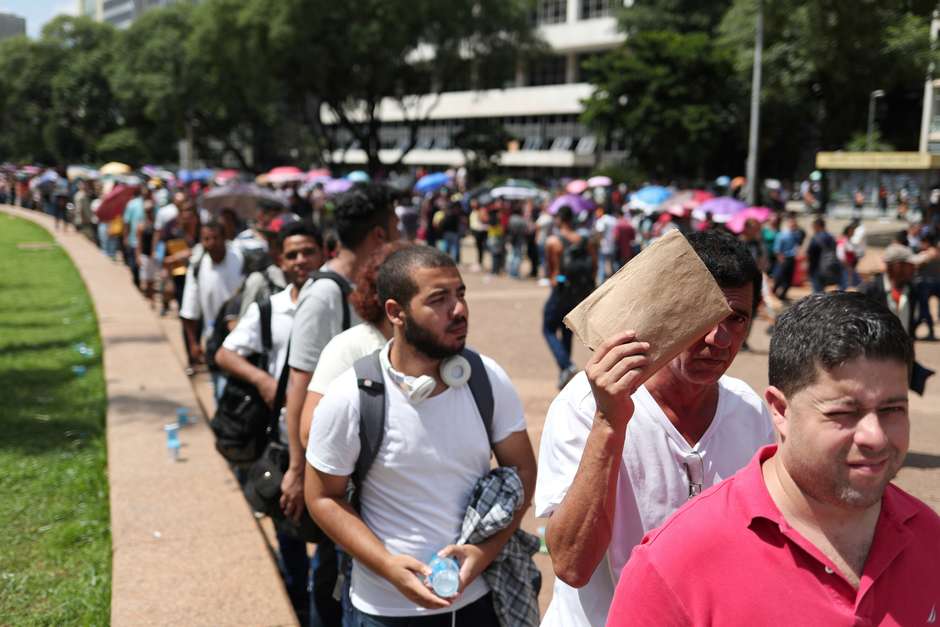RIO DE JANEIRO, BRAZIL – While the formal employment survey by the Ministry of Economy, the CAGED, found a decline in the rate of layoffs of workers with a signed worker’s record book, in June, the IBGE (Brazilian Institute of Geography and Statistics) Continuous PNAD (Continuous National Household Sample Survey) reports that the impact of the Covid-19 pandemic on the labor market is still devastating.
During the second quarter this year, the first completely under the impact of the health crisis, 8.9 million people lost their jobs.
According to economist Daniel Duque, a researcher in the area of Applied Economics at the IBRE (Brazilian Institute of Economics) of the Getúlio Vargas Foundation (FGV), the data released on Thursday, August 6th, by the IBGE show a continued deterioration of the labor market.

“What surprised me was that there was no sign of a rebound or a slowdown in the deterioration of the labor market by the Continuous PNAD,” he says.
According to the researcher, the unemployment rate in the quarter was no worse because people are leaving the workforce. In other words, those who were fired or were unable to work, as is the case with many casual workers, are not yet looking for jobs.
The IBGE says that only those who looked for a job and were unable to find one in the 30 days prior to the survey are classified as unemployed.
The R$600 (US$120) emergency aid also has a positive impact on the unemployment rate. Duque says there should be an acceleration of the unemployment rate unless the benefit paid by the government is not extended.
Question – The Continuous PNAD released on Thursday provides data from the most critical period of the pandemic, from April to June. What did you consider more relevant?
DD – It shows that June continues to experience a worsening in the labor market. Some people expected a rebound, because the CAGED data reported a reasonable improvement of the situation in relation to the worst moment, which were the months of April and May mainly April.
But the Continuous PNAD, on the contrary, showed a continued deterioration of the labor market situation, with an even greater drop in the number of occupations, an even greater increase in discouragement and underutilization of labor.
So what really surprised me was that there was no sign of a rebound or a slowing down of the deterioration of the labor market by the Continuous PNAD. When the CAGED came out, members of the economic team said dismissals had slowed and unemployment was still high because there was no hiring.
There was a huge mismatch between the Continuous PNAD and the CAGED. The drop in jobs with the PNAD’s signed worker’s record book between May and June was one million jobs. In the CAGED, the reduction was 11 thousand. That doesn’t make much sense. Even with one or two deviations, it is unusual to see such a large discrepancy. That raises some assumptions, such as a delay in recording dismissals. The number of people who left the labor force is very similar to the number who left the occupied population.
Is that why the number of unoccupied people has remained stable?
DD – That’s exactly why. People who are losing their jobs are not looking for new ones. I ran an exercise showing that if the labor force – which includes both the occupied and the unoccupied – were the same as in the quarter ended in February this year, we would currently have a 21.4 percent unemployment rate.
The departures from the labor force are holding back the unemployment rate. It is at a high rate and yet it would be much worse if it weren’t for people leaving the workforce.
How many people would these 21 percent unemployed represent?
DD – Today the labor force consists of 96 million people. In February, there were 106 million, ten million more. There are now 12.8 million unemployed, the equivalent of 13.3 percent of the labor force. If we had the same labor force as in February 2020 and the same occupied population as today, we would have 20.6 million unemployed.

With the months progressing, with more activities being released and social distancing more relaxed, do you think these people who have left the labor force or who are discouraged will start looking for jobs again? Is there a risk of reaching an unemployment rate of 21 percent?
DD – Maybe it will not reach 21 percent because there will be a rebound of the occupied population, but surely the unemployment rate will increase as the emergency aid ends.
We have a situation where, in all likelihood, the unemployment rate will exceed 15 percent, but I find it difficult for it to reach 21 percent. People who return to the labor force should be able to secure employment as there is some cyclical rebound after the pandemic.
What does this reduction in the labor force, which has contained the pressure on the unemployment rate, tell us about the situation of the economy and the labor market?
DD – There are three reasons. One is the fear of catching Covid-19. People avoid leaving home – they have to leave home to look for work. Then, people know who don’t have a job in their areas are aware of it. And third, while they know it is difficult to find a job, many people are receiving emergency aid. So there is some income, and R$600 is a lot for many people.
What should we expect for the coming months?
DD – Covid PNAD, which comes out weekly, has not yet provided any indication of a robust rebound in the job market. The workforce itself and the rate of participation, which were increasing, have again failed to have a clear direction.
In other words, people are realizing that, despite the relaxation of restrictions, there is still no significant economic and employment rebound. At least for July and August, I don’t have much hope that we will have any reaction from the labor market.
Maybe in the following month, but this will coincide with the reduction or the end of the emergency aid, which will cause many people to look for work again and this will put considerable pressure on the unemployment rate.
Can you confirm the Secretary of Economic Policy Adolfo Sachsida’s projection that there will be a rebound in unemployment numbers in September?
DD – No doubt there will.
Source: Folhapress

